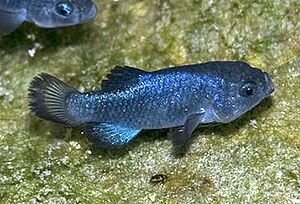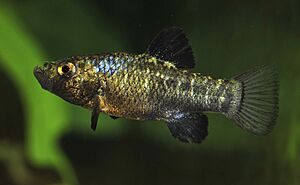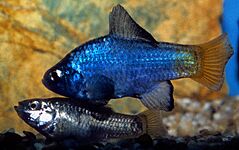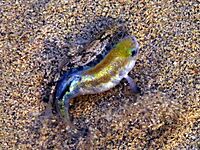Cyprinodon facts for kids
Quick facts for kids Cyprinodon |
|
|---|---|
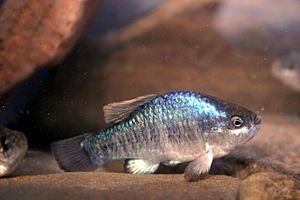 |
|
| Cyprinodon radiosus | |
| Scientific classification |
|
| Kingdom: | Animalia |
| Phylum: | Chordata |
| Class: | Actinopterygii |
| Order: | Cyprinodontiformes |
| Family: | Cyprinodontidae |
| Subfamily: | Cyprinodontinae |
| Genus: | Cyprinodon Lacépède, 1803 |
| Type species | |
| Cyprinodon variegatus Lacépède, 1803
|
|
| Synonyms | |
|
|
Cyprinodon is a group of small fish known as pupfish. They live in many different types of water. These can range from freshwater to very salty water, even saltier than the ocean.
You can mostly find these fish in Mexico, the Caribbean Islands, and the southern United States. Some species, like C. variegatus, live as far north as Massachusetts. Others are found in northern South America. Most pupfish are quite small. The biggest ones grow to about 10 centimeters (4 inches) long. Many other species are only half that size. Sadly, many Cyprinodon species have very small homes. This means they are highly endangered, and some have already disappeared forever.
Contents
Where Pupfish Live and Their Homes
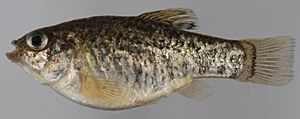
While a few Cyprinodon species live in large areas, most have tiny homes. Often, they are found in just one or two Mexican or U.S. states. Some live only on a single island in the Caribbean. For example, the C. diabolis lives only in a small pool called Devils Hole in Nevada. This pool has a shelf that is only about 18 square meters (194 square feet) in size.
Pupfish live in many different places. These include springs, pools, lakes, and coastal lagoons. They can also be found in creeks, streams, and rivers. They can handle a huge range of water conditions. This includes very hot springs, like where C. julimes lives in water up to 46°C (115°F). Some even live in water that is much saltier than the sea.
Some pupfish can even survive big changes in temperature and saltiness. For instance, certain C. variegatus populations can live where the water temperature drops from 15°C (59°F) to -1.8°C (29°F) in less than a day! When it gets very cold, they bury themselves in the mud. The C. salinus pupfish can live in water that changes by 19°C (34°F) in a day. Its habitat's saltiness can also change a lot, from less than one-third of seawater to almost five times as salty.
Saving Pupfish: Their Conservation Status
Most pupfish species are in serious danger. Some, like C. arcuatus and C. ceciliae, are already extinct. This means they have completely disappeared from Earth. These extinct species mostly lived in small spring systems in the U.S. or Mexico.
Three species from Mexico, C. alvarezi, C. longidorsalis, and C. veronicae, are now extinct in the wild. This means they only survive in special tanks in captivity. Other Mexican species, like C. maya, are also very endangered. They might only exist in captivity too.
One of the rarest pupfish still in the wild is the C. diabolis from Devils Hole in Nevada. Its population has been very small, sometimes only a few dozen fish. The biggest dangers to pupfish are losing their homes. This happens because of water being taken away, droughts, and pollution. Also, new species of fish or plants introduced by humans can harm them.
Pupfish Behavior
How Pupfish Eat
Most Cyprinodon species eat tiny plants like algae and cyanobacteria. They also eat detritus, which is decaying matter. Sometimes, they add small crustaceans (like tiny shrimp) and water insect larvae to their diet. Some species mainly eat small animals, such as aquatic insects.
One interesting pupfish, C. desquamator, is known as the scale-eating pupfish. It actually eats the scales off other fish! In places where several pupfish species live together, they have found different ways to eat. For example, C. maya eats other fish. C. simus eats tiny water animals called zooplankton.
How Pupfish Breed
On right: Cyprinodon salinus pair during spawning (male with yellowish back).
Cyprinodon pupfish usually do not live very long. Most only live for about a year in the wild. However, some can live up to three years. Pupfish that live in places with big environmental changes, like temperature swings, grow up very fast. They can start breeding when they are only 1 to 1.5 months old.
Even though some pupfish can live in a wide range of temperatures, they need more specific conditions to breed. For example, some C. nevadensis can live in water from 2°C (36°F) to 44°C (111°F). But they only breed when the water is between 24°C (75°F) and 30°C (86°F). Pupfish in stable homes breed all year. Those in places with seasons usually breed only when conditions are best. When it's time to breed, male pupfish get bright, colorful patterns.
There are two main ways pupfish breed. In small, isolated places like springs, a large male will defend an area. He will show off to females who visit. The females then lay their eggs in his territory. Neither parent cares for the eggs after they are laid. However, the eggs are somewhat protected inside the male's territory. A male tries to attract many females to lay eggs in his spot. A female might lay eggs in several males' territories.
Another breeding method is used by pupfish living in rivers. Here, males do not defend a territory. Instead, groups of pupfish gather to breed. A male will usually lead a female to the edge of the group to lay eggs. Sometimes, it happens in the middle of the group. Pupfish eggs are sticky and attach to the bottom of the water. Sometimes, they get covered in sand.
Species
There are currently 49 recognized species in this genus. Some notable ones include:
- Cyprinodon arcuatus (Santa Cruz pupfish) - now extinct.
- Cyprinodon diabolis (Devil's Hole pupfish) - very rare.
- Cyprinodon desquamator (Scale-eating pupfish) - unique for its diet.
- Cyprinodon julimes (Julimes pupfish) - discovered recently in 2009.
Images for kids
-
Cyprinodon eremus in shallow water, which is preferred by most species in this genus


